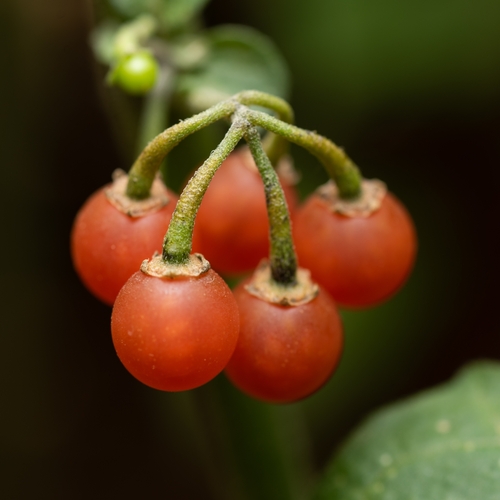|
| Common Animals Fish Mushrooms Flora |
Solanum villosum |
June: Flowering continues, and fruits start to form.
Used cautiously in folk medicine due to alkaloid content. Applied for treating skin diseases and as an anti-inflammatory agent.
Hairy nightshade is an annual or perennial plant with dark blue berries. Grows in Europe, Asia, and North America, often in open areas.
Handpicking ripe berries, preferably in dry weather. Harvesting young leaves for use after processing.
Harvest berries when fully ripe, turning dark blue. Collect leaves before flowering to reduce bitterness and toxicity.
Fruits and leaves contain alkaloids and require thorough cooking. Multiple boiling and rinsing are recommended before consumption.
Decoction of hairy nightshade berries (Multiple boiling with rinsing)
Used only for medicinal purposes
Used only for medicinal purposes
1. Collect ripe berries.
2. Wash and cover with water.
3. Boil for 10 minutes, drain water.
4. Repeat boiling 2-3 times.
5. Use only after professional consultation.
2. Wash and cover with water.
3. Boil for 10 minutes, drain water.
4. Repeat boiling 2-3 times.
5. Use only after professional consultation.
Decoction of hairy nightshade leaves (Boiling with subsequent rinsing)
Used cautiously in folk medicine
Used cautiously in folk medicine
1. Collect young leaves.
2. Wash and boil for 10 minutes.
3. Drain water and repeat boiling twice.
4. Use as directed.
2. Wash and boil for 10 minutes.
3. Drain water and repeat boiling twice.
4. Use as directed.
Tincture of hairy nightshade berries (Infusing berries with alcohol)
Used in traditional medicine under supervision
Used in traditional medicine under supervision
1. Collect and slightly dry berries.
2. Cover with alcohol or vodka.
3. Infuse for 2 weeks in dark place.
4. Strain and take in small doses.
2. Cover with alcohol or vodka.
3. Infuse for 2 weeks in dark place.
4. Strain and take in small doses.
Use of decoction for external application (Using decoction for compresses)
Helps with skin conditions
Helps with skin conditions
1. Prepare decoction from berries or leaves.
2. Soak cloth and apply to affected area.
3. Repeat 2-3 times daily.
2. Soak cloth and apply to affected area.
3. Repeat 2-3 times daily.
 United States · Texas · Hays
United States · Texas · Hays

